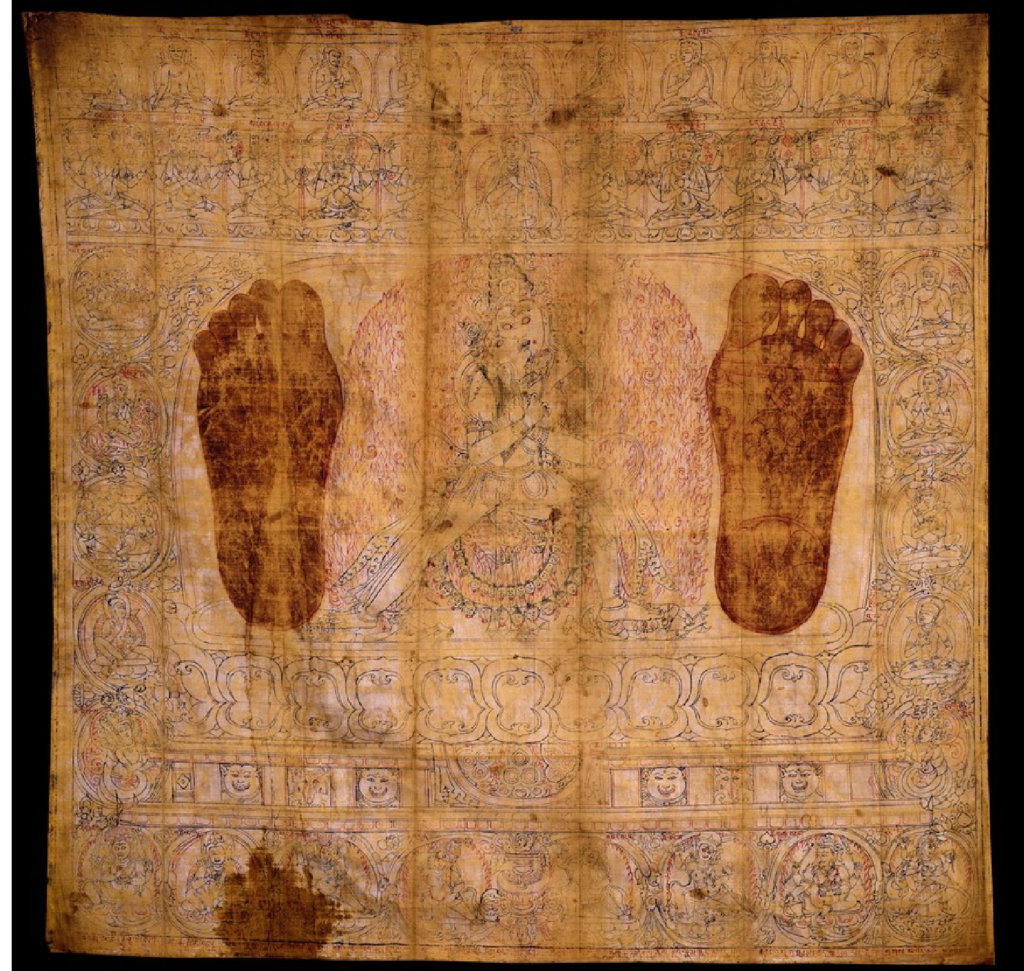
Disponible también en español
Most accounts of lineage in Buddhism—particularly in Tibetan Buddhism—present lineage as a singular, linear progression from a singular master to a singular disciple, one name after another, one generation to the next. This gives the impression of lineage being similar to a family tree, though with only one male child per generation, who somehow solely and singularly continues the family line to the next generation. But just as such a family is biologically impossible, so is such a continuity of lineage implausible, if not impossible. While there is a certain directness and cleanness in presenting a lineage in this way, an imagined “string of pearls” succession, charting a spiritual lineage is always something way messier (read: richer!) and complex (read: realistic!) than the narrative that is commonly represented and repeated in “lineage talk” at Dharma-centers. Thus the Kagyu lineage is often charted out as follows: Vajradhara (the primordial buddha) ➝ Tilopa ➝ Naropa ➝ Marpa ➝ Milarepa ➝ Gampopa. And if you are part of the Drikung branch of the Kagyu family, then from Gampopa you continue on to Pakmodrupa ➝ Drikungpa Jikten Sumgon. In this telling, each generation has a single pearl or golden bead, a great master who is part of a string or rosary of pearls. In fact, in the Kagyu lineage, the continuity of such a lineage of masters is actually called “the golden rosary” (Tibetan: ser-treng གསེར་’འཕྲེང་). As expedient as such a narrative can be, this “string of pearls,” this “golden rosary,” conceals as much as—if not more than—it reveals. Even a casual look at the biographies of lineage luminaries such as Tilopa, Marpa, or Pakmodrupa quickly reveals that each of them had more than one teacher in their lives both before and after training with their main teacher. Furthermore, just as their spiritual progenitors are always multi- and never single-sourced, their spiritual descendants are also often prolific and diverse in their branching out.
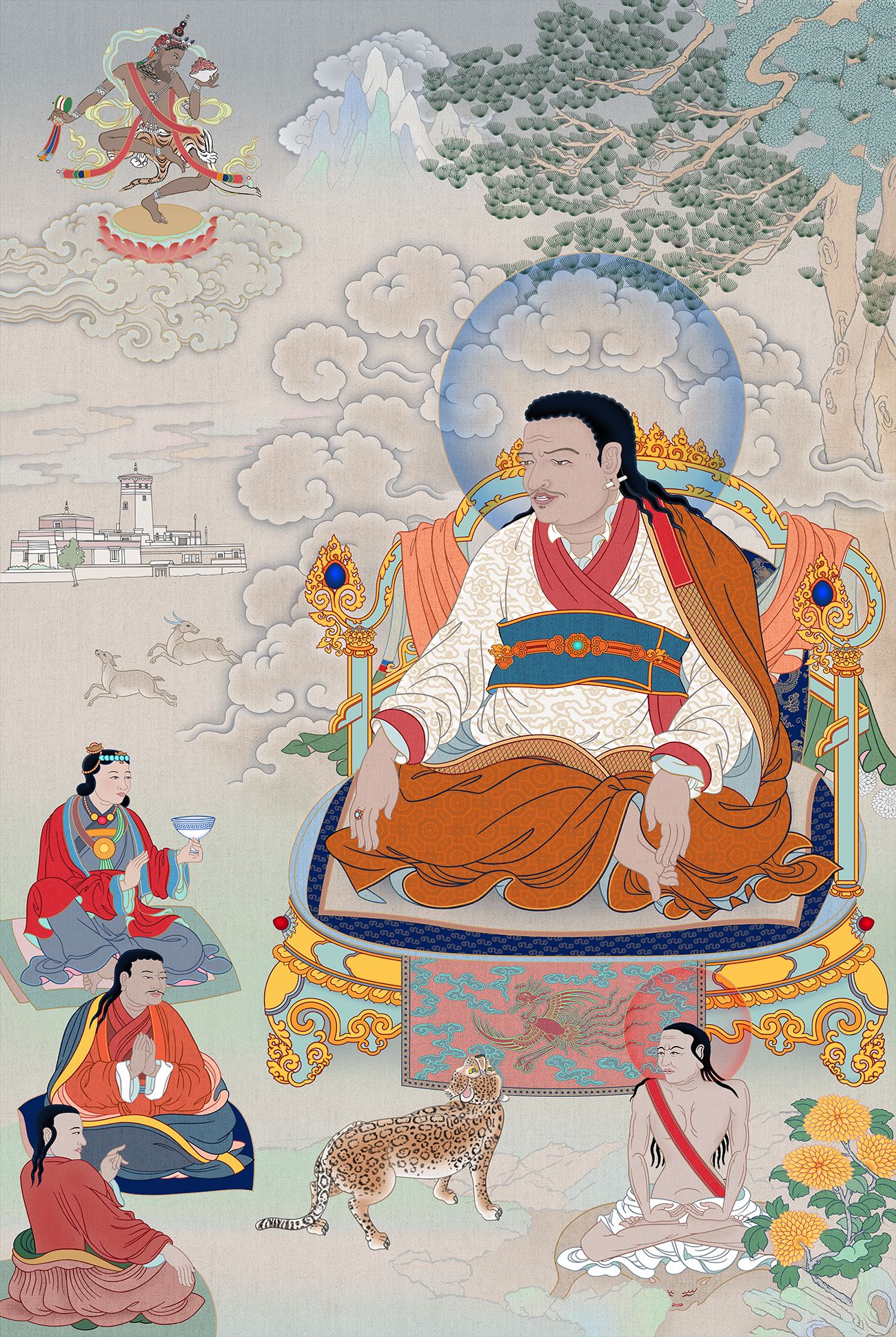
Artwork by Christopher Banigan
While Dr. Lye’s teachings on lineage generally and on the Drikung Kagyu lineage in particular, do anchor on the traditional “golden rosary” narrative, he also tells the story of lineage being a multi-faceted, multi-layered, and multi-directional process. Each lineage master was influenced and trained by many teachers and each of them in turn taught and trained many disciples. Furthermore, Dr. Lye often emphasizes that we must appreciate that “lineage” is necessarily something produced or constructed and understood backward. Lineage is the result of a series of deliberate, retrospective actions. From this perspective, lineage doesn’t actually begin with “the primordial Buddha, Vajradhara.” Instead, “lineage” necessarily begins with me—with you. At some point in your practice of Tibetan Buddhism, you may start to identify from among the several and different influences and individuals a specific teacher as your primary inspiration and source of Dharma. And from there, we work backward identifying (read: constructing) “my lineage.” So lineage is as much a downward flow from the primordial buddha, Vajradhara, down to our own teacher(s) as it is also an upward flow—a reversal—from us to Vajradhara! Dr. Lye teaches that it is in recognizing this dynamic dialectic of a downward- upward flow, a lineal-circuitous pathway, of any spiritual lineage that the power of connecting with a lineage can authentically come alive for us, and in us. We begin to see how the foundational Buddhist teaching of the interdependent nature of all phenomena manifests in the context of lineage. With this general understanding of lineage (and the process of subjective “lineage-building”), we shall now look at some of the specifics of the Kagyu lineage and one particular branch of this family known as Drikung Kagyu.
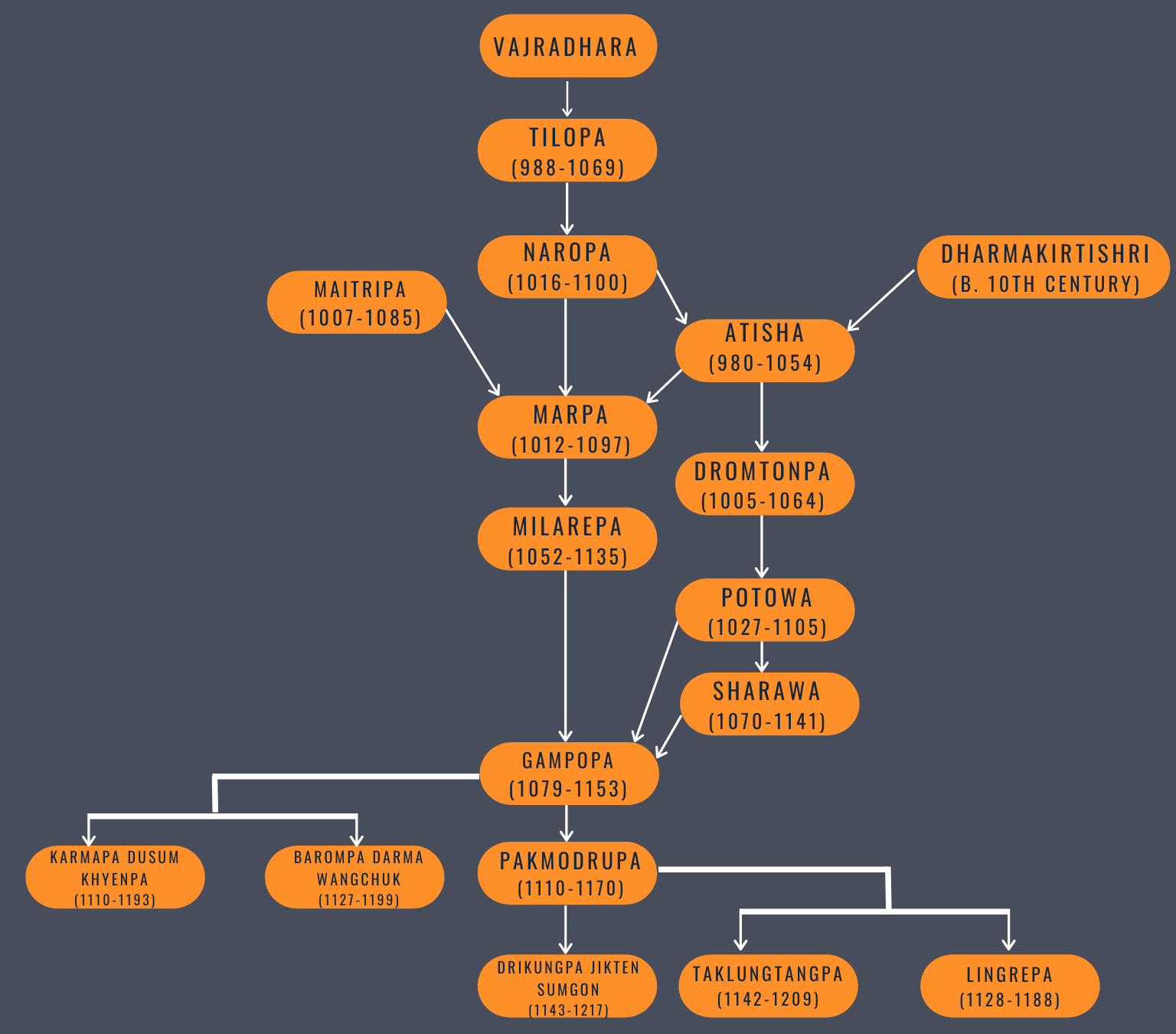

The origination of the Kagyu lineage of Tibetan Buddhism is generally identified with MARPA Chokyi Lodro (ca. 1012–1097) of the Lhodrak region of Southern Tibet. He was born into a family of modest means but his father recognized his aptitude for learning languages, and so sent him at the age of fifteen to learn classical Sanskrit and various Indian vernacular languages from the famous scholar and Buddhist master, Drokmi Lotsawa (who was also the Tibetan source of the Sakya lineage’s lamdre transmission). After a few years with Drokmi, Marpa made his first journey to Nepal and India where he trained with a great number of teachers—chief among them the illustrious Naropa (ca. 1016–1100). This first journey lasted twelve years, divided chiefly between Kathmandu Valley and Pullahari (in the modern Indian state of Bihar), where Marpa studied and trained with Naropa and other teachers to whom Naropa sent him to learn. Later, Marpa made two other journeys in search of the Dharma and spent close to twenty years in South Asia altogether, receiving transmissions from at least thirteen mahasiddhas—male and female—with Naropa as his root guru.
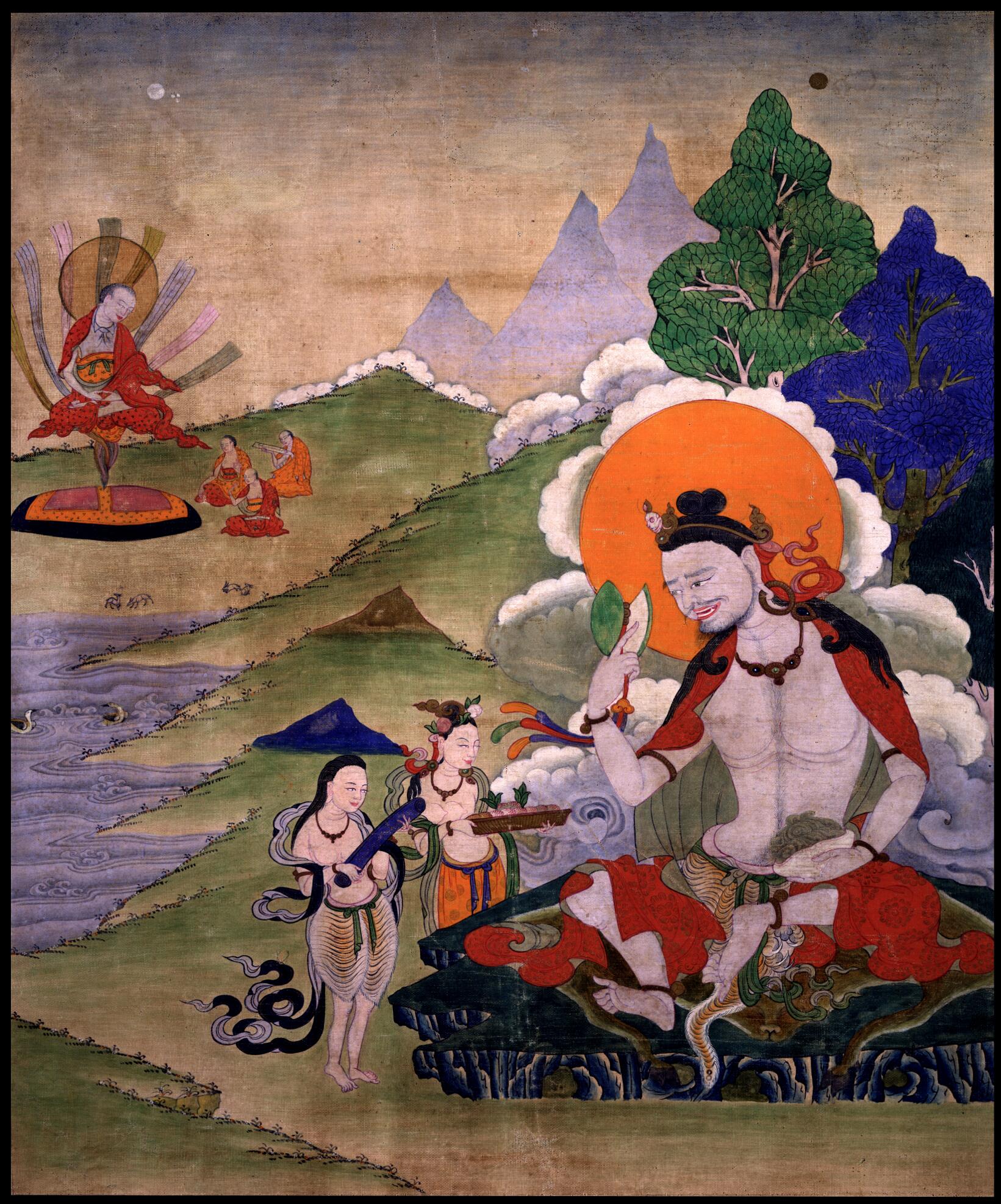
Since NAROPA was Marpa’s main teacher, he is thus identified as the “bead” that comes before Marpa in the standard Kagyu “golden rosary,” Naropa was born into privilege as the son of a Bengali Indian king. Displaying an affinity with spirituality from a young age, Naropa first studied and practiced the non-Buddhist systems available around him before journeying to Kashmir in pursuit of the Buddhadharma. He later returned to Bengal to fulfill his parent’s wish for him to marry a woman they had chosen for him. After some years of being married, we are told that he and his wife agreed to dissolve their union and both took up Buddhist monastic life. From that point on, Naropa fully dedicated his life to the Dharma. After training with various teachers at different locations across Northern India, Naropa eventually achieved a prominent position at the famed university of Nalanda and was admired and respected by all as an erudite monk-scholar. But Naropa had yet to reach his true potential and significance. Tibetan accounts tell us of a mysterious but life-transforming encounter between Naropa and “a woman with thirty-two ugly features” who led Naropa to abandon his position and privilege at Nalanda in search of Tilopa, who had been “his guru for seven lifetimes.” Tilopa skillfully and patiently trained Naropa for more than a decade until Naropa was completely liberated and became a great tantric teacher to many far and wide.
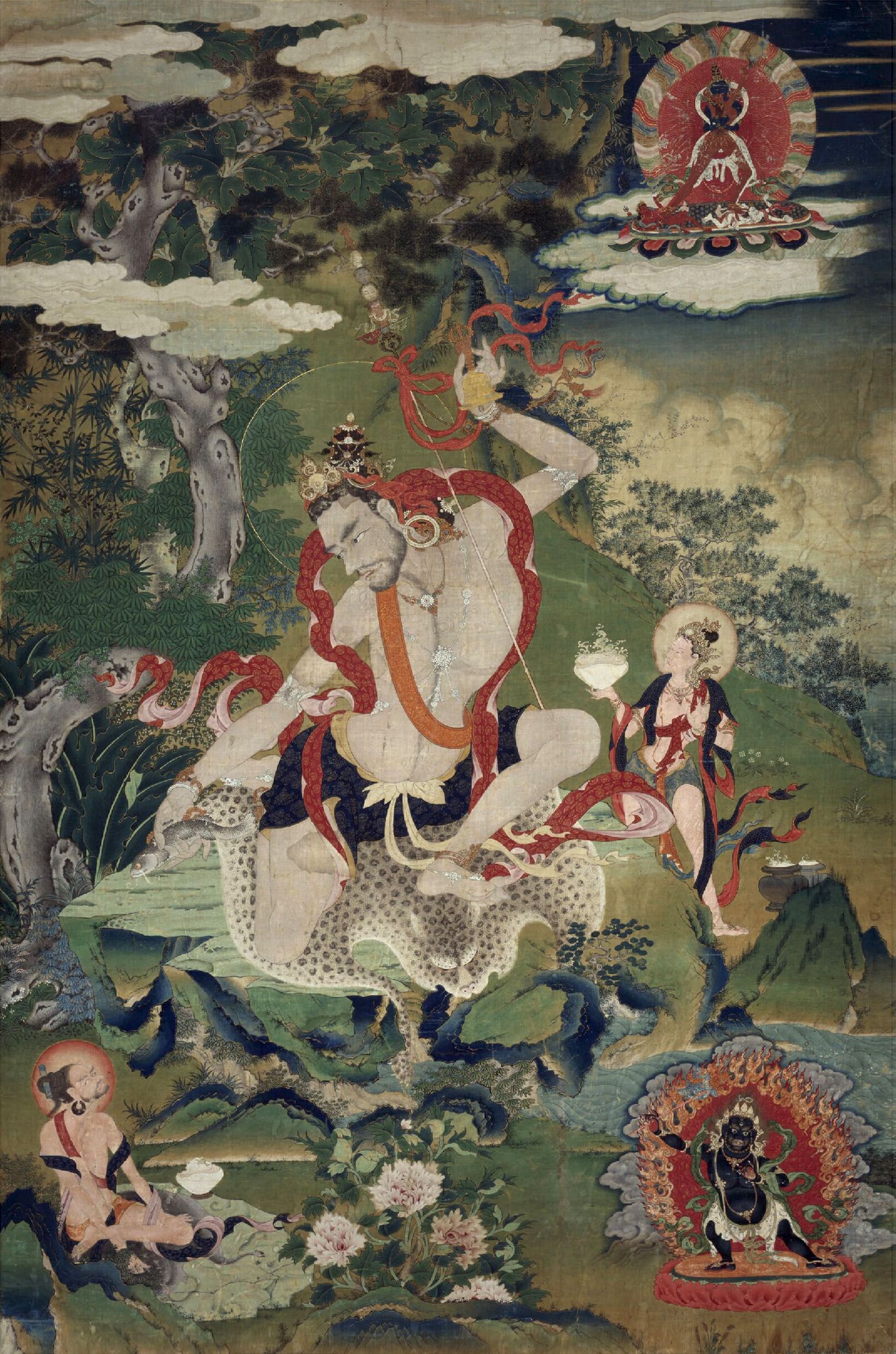
Like Naropa, TILOPA (ca. 988–1069) was also from Bengal, with some accounts identifying his birthplace as Chittagong (in present-day Bangladesh). Born into the brahmin caste, his family was apparently Buddhist and of modest means compared to Naropa. We don’t know much about Tilopa that is historically reliable but Tibetan sources tell us he became a Buddhist monk early in his life and received a classical monastic education, but later wandered as an itinerant yogi seeking out Vajrayana teachers and transmissions (codified into what is known as “the four transmissions,” or in Tibetan, bka’ babs bzhi). Although biographies clearly show that Tilopa trained with many mahasiddhas in many different tantric techniques and systems, the Kagyu “golden rosary” accounts universally identify Vajradhara as Tilopa’s direct guru. Thus the Kagyu lineage of Tibetan Buddhism often considers Tilopa as the first “bead” in the “golden rosary” who directly received the transmissions that passed down to Naropa and others from the primordial buddha Vajradhara itself.
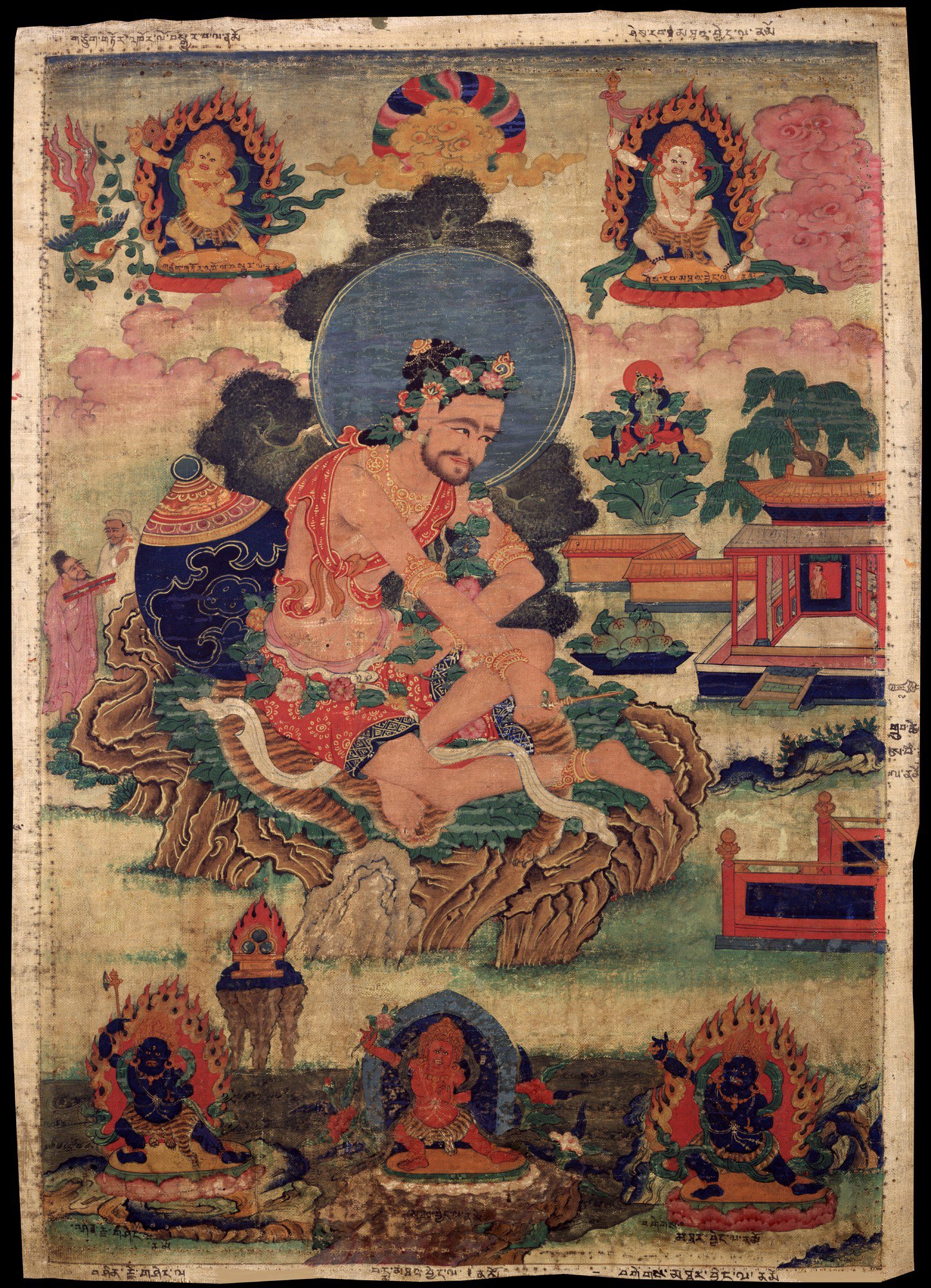
Although “golden rosary” biographies of all different branches of the Kagyu family present the narrative of lineage succession as singular and linear from Tilopa to Naropa to Marpa, we should bear in mind that Marpa’s biographies don’t hide the fact that he trained with many teachers throughout his three journeys to India and Nepal. In particular, MAITRIPA (ca. 1007–1085) was an important source of Marpa’s mahamudra transmission. Maitripa’s works form one of the main sources for later Kagyu-style mahamudra practice that emphasizes nonconceptual realization (Skt. amanasikara), a style of mahamudra that blends sutra and mantra traditions. Maitripa’s extensive use of sutric sources in his approach to mahamudra—sources such as the Ratnagotravibhaga (also known as Uttaratantra) treatise—is a unique characteristic of Kagyu mahamudra that other Tibetan mahamudra traditions sometimes considered as inauthentic or even erroneous. With the encouragement of Naropa, Marpa received mahamudra teachings from Maitripa, spending a total of seven years with him.
Marpa’s biographies also mention meeting another key figure of Indian Buddhism at that time. ATISHA (ca. 980–1054) was another prominent Bengali Buddhist master, having trained in the great seats of learning of Buddhist India such as Nalanda, Odantapuri and Vikramashila and spent twelve years training with the Sumatran master Dharmakirtishri (known as Serlingpa in Tibetan sources) in what is now Indonesia. Atisha also received Vajrayana and mahamudra training from Naropa, with Naropa proclaiming that Atisha had perfectly actualized all that Atisha had received from him. Atisha’s qualifications and reputation were so far-reaching that the kings of Purang in western Tibet sent envoys to invite him to help re-establish Buddhism in Tibet after a period of decline that began with the reign of the king Langdarma (d. 841). Although Atisha was initially hesitant, in time with the intervention of his personal deity Tara, he left India for Tibet. Atisha was en route in Nepal when his Tibetan translator died, and it was there and then that he met Marpa who was on his way to India. Although Atisha failed to persuade Marpa to act as his translator, Marpa’s biographies tell us he did receive several transmissions from Atisha, transmissions that Marpa passed on to his spiritual descendants. As we shall see later, Atisha’s influence on the Kagyu lineage will also come through the Kadam lineage that arose in Tibet as a result of his teachings and activities there.
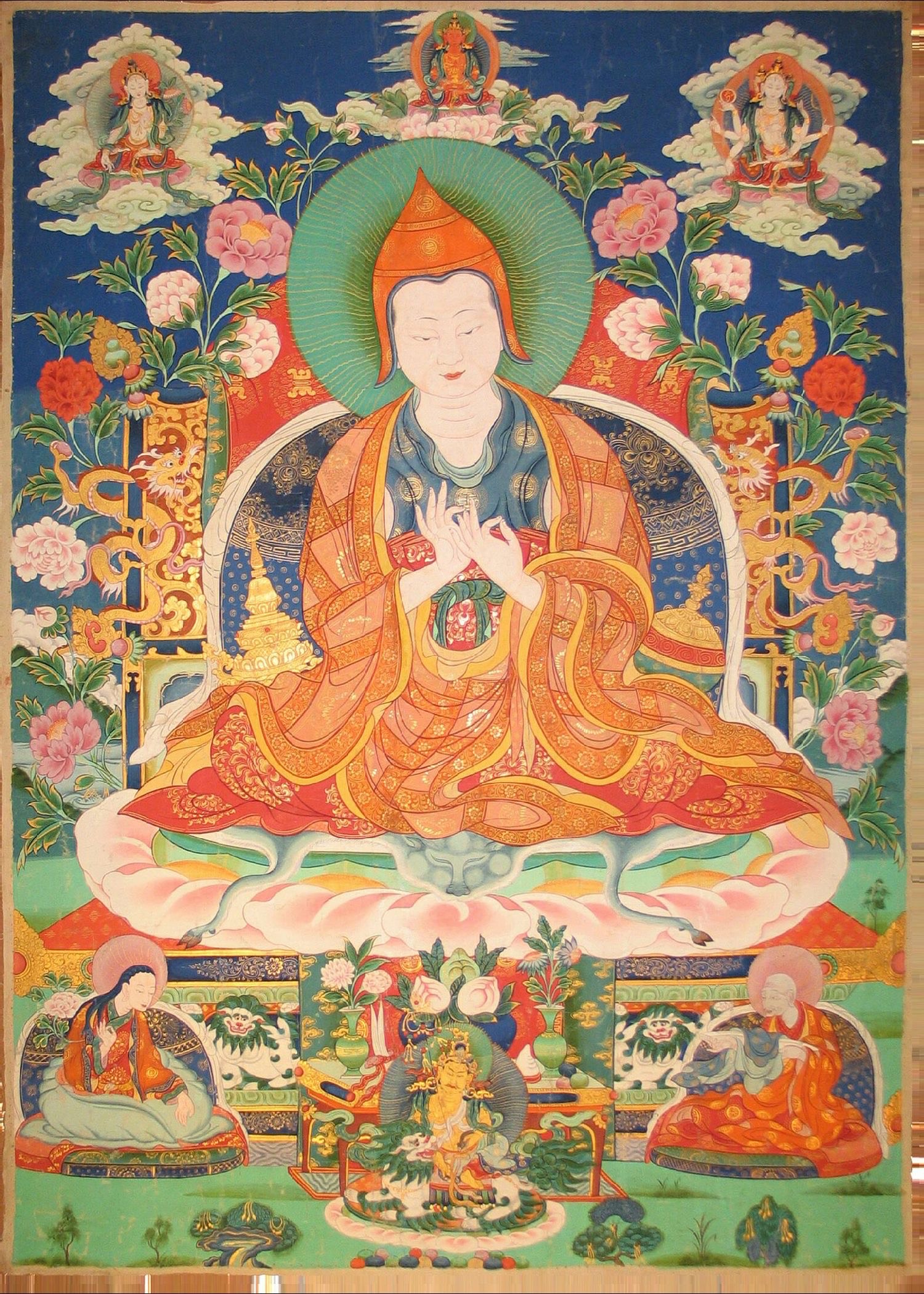
After twenty years of training over three arduous journeys to Nepal and India, Marpa eventually gained fame as a reliable and authentic source of Vajrayana practice, attracting many disciples back in Tibet. His family wealth and standing grew over time as disciples gathered. Holder of many major and minor Vajrayana transmissions from India and Nepal, Marpa specialized in The Six Dharmas of Naropa (Tibetan: naro chodruk ན་རོ་ཆོས་དྲུག་) and mahamudra (Tibetan: chakgya chenpo ཕྱག་རྒྱ་ཆེན་པོ་). These two sets of practices form the spiritual core of a community of teachers and students who will eventually self-identify as members of the Kagyu lineage.
There is no doubt that Marpa Chokyi Lodro was one of the key tantric teachers of his time. Unlike most of the Kagyu luminaries that came after him, Marpa lived as a family man and a wealthy landowner. Many of his immediate students also seemed to have come from well-to-do backgrounds. Chief among his spiritual successors were Ngokton Choku Dorje (1036–1097), Tsurton Wanggi Dorje (n.d.) and Milarepa (1052–1135). The most prominent student of Marpa’s at that time was clearly Ngokton Choku Dorje who excelled in the exegesis and practice of the tantras transmitted by Marpa. Ngok’s family lineage upheld what was known as the “Seven Mandalas of Ngok” which Ngokton Choku Dorje received from Marpa. However, the world now knows Milarepa the best and recognizes him as Marpa’s main successor.
Like Marpa, MILAREPA also grew up in a modest but comfortable family until the death of his father in his early teens. His dramatic and inspiring life story is powerfully retold in Tsangnyon Heruka’s well-known biography composed in the 15th century. We should point out here that earlier biographies of Milarepa paint a slightly different picture of Milarepa’s early life. In them, Milarepa’s trajectory toward the Dharma was less dramatic than the version by Heruka that most of us know. These earlier biographies present a young man who started his Dharma education early in life, encouraged by his father. Milarepa learned both sutra and secret mantra teachings from various teachers, and received both mahamudra and dzokchen transmissions. In fact, his mahamudra teacher (who taught “nature of mind according to the sutra tradition”) encouraged him to seek out Marpa, as Marpa was reputed to have supreme methods for igniting the realization of mahamudra in those who trained with him. Thus Milarepa joined the ranks of Marpa’s disciples even though he was too poor to afford the payments that Marpa apparently demanded of his students.
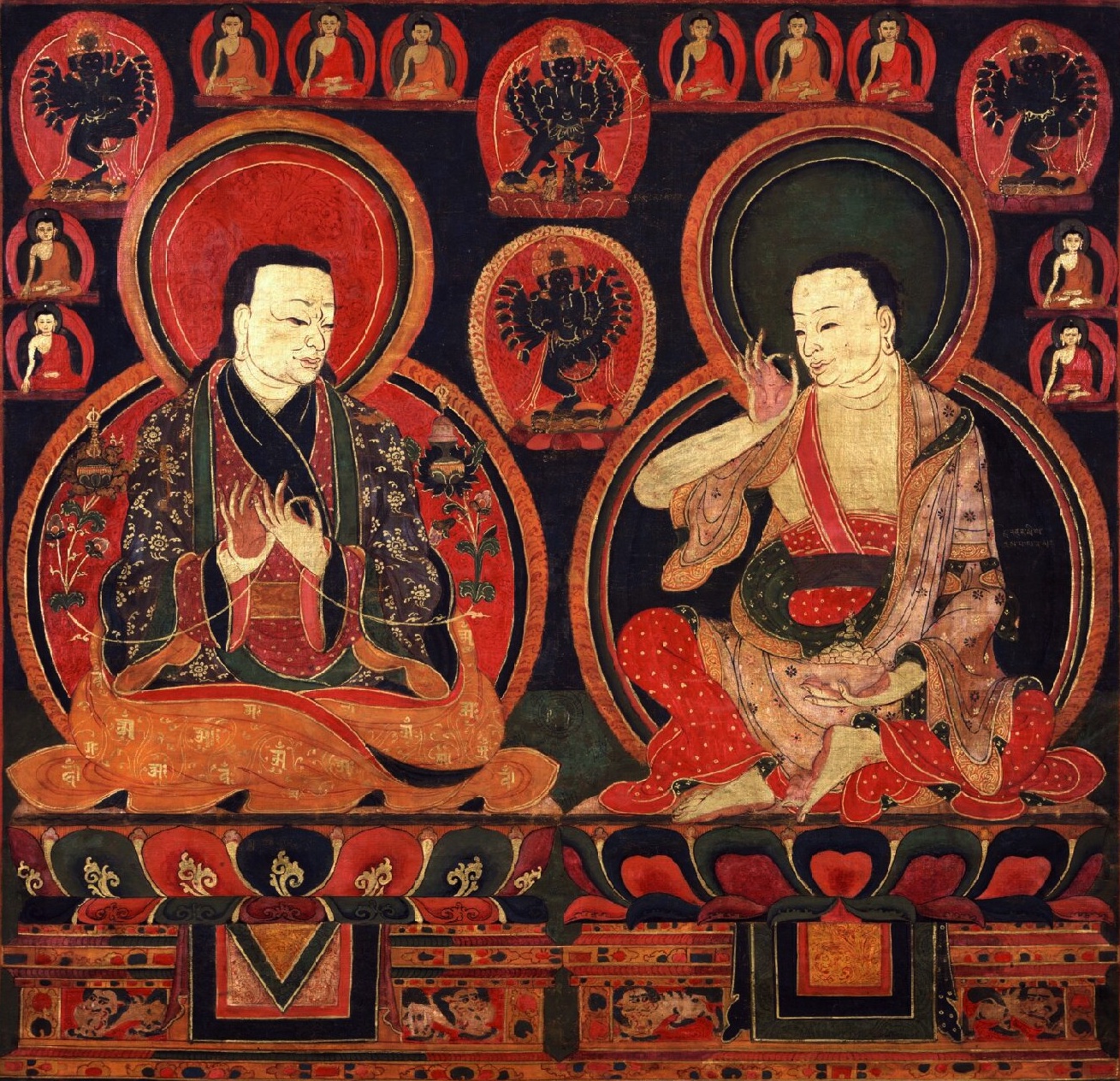
Regardless of the details that led Milarepa to Marpa, early and later biographies universally present one of the most inspiring examples of a Tibetan who dedicated his entire life to realizing the Dharma through relentless dedication to practice while living a simple, itinerant life, mostly in the wild and rarely residing in towns or villages. Milarepa eschewed both the more conventional monastic life of the majority of serious Dharma practitioners of his time, and also the family life exemplified by his teacher, Marpa and other of Marpa’s key disciples. In Milarepa’s life, there were no delicate brocades, golden thrones, impressive public rituals or collection of voluminous texts. There were no training programs, philosophical studies or credentialing processes in Milarepa’s circle. Master and disciples were bound together with mutual devotion and care for each other and sustained by a fierce and uncompromising commitment to experiencing and realizing the Dharma, here and now. Although he probably never had more than a handful or two of like-minded disciples who wandered the snow mountains of Tibet and Nepal with him, Milarepa left a spiritual legacy that permeated Tibetan religiosity, especially among members of the Kagyu lineage who have looked to him as one of their key spiritual forefathers—even though the majority of Kagyu disciples after him lived a more normative monastic lifestyle. In the words of His Holiness Drikung Kyabgon Chetsang Rinpoche, one of the two current co-heads of Drikung Kagyu:
The Snow Land’s crown-jewel of the Practice Lineage, Jetsün Mila,
In one lifetime attained the state of Vajradhara and opened the sky-path.
Hundreds of thousands of saffron-robe wearers who followed after him
Lit up the sky with the color of dawn,
Crowding the purelands to near bursting,
Filling them with an ocean of Kagyu mahasiddhas!
GAMPOPA (1079–1153) in many ways is the actual founder of the Kagyu lineage as we know it today. Before “Kagyu” (literally “the transmission of oral instructions,” or bka’ brgyud in Tibetan) became the name for the lineage represented and founded by Gampopa, this name was earlier used loosely by various other groups centered around other traditions of practice. Thus in historical texts, we find references such as “Atisha Kagyu” and “Jonang Kagyu.” These are “the transmission of oral instructions originating from Atisha,” or “the transmission of oral instructions originating from the Jonangpas.” Thus in this early period, “Kagyu” did not exclusively refer to a single group but was a preferred term used by several groups to refer to the particular transmission or lineage that they held. Only over time did “Kagyu” come to refer exclusively to the lineage held by Gampopa and a particular line of his spiritual genus. Before becoming a spiritual practitioner, Gampopa was apparently a physician of note. He only ordained as a monk at a Kadam monastery after the traumatic loss of his wife to an illness. As a Kadam monk, Gampopa studied philosophy, doctrine, and logic and trained in sutra and secret mantra practices according to Atisha’s transmissions of these teachings. Among his teachers before he met Milarepa were important Kadam masters such as Jayulwa (1075–1138), Potowa (1027–1105), and Sharawa (1070–1141). The influence of these masters on Gampopa cannot be overstated, even if the more normative telling of Gampopa’s spiritual pedigree tends to emphasize Milarepa’s importance at the cost of these Kadam masters. The usual narrative regarding how Gampopa ended up training with Milarepa highlights how he was inexplicably moved to seek out Milarepa when he overheard some random beggars talking about Gampopa. When Gampopa finally met Milarepa, he was bluntly told by Milarepa that “the Kadam teachings lacked power” to take Gampopa all the way because Atisha’s royal patrons prevented him from teaching the totality of his realization. Gampopa ended up staying with Milarepa for more than a year, receiving instructions and transmissions, and practicing in retreat. After leaving Milarepa, he continued to practice mostly in retreat for the next twelve years—an instruction given to him by Milarepa. Gampopa finally settled in the Gampo region in 1121 and established a monastic community there, and in due time many monastic disciples (“saffron- robe wearers”) gathered.
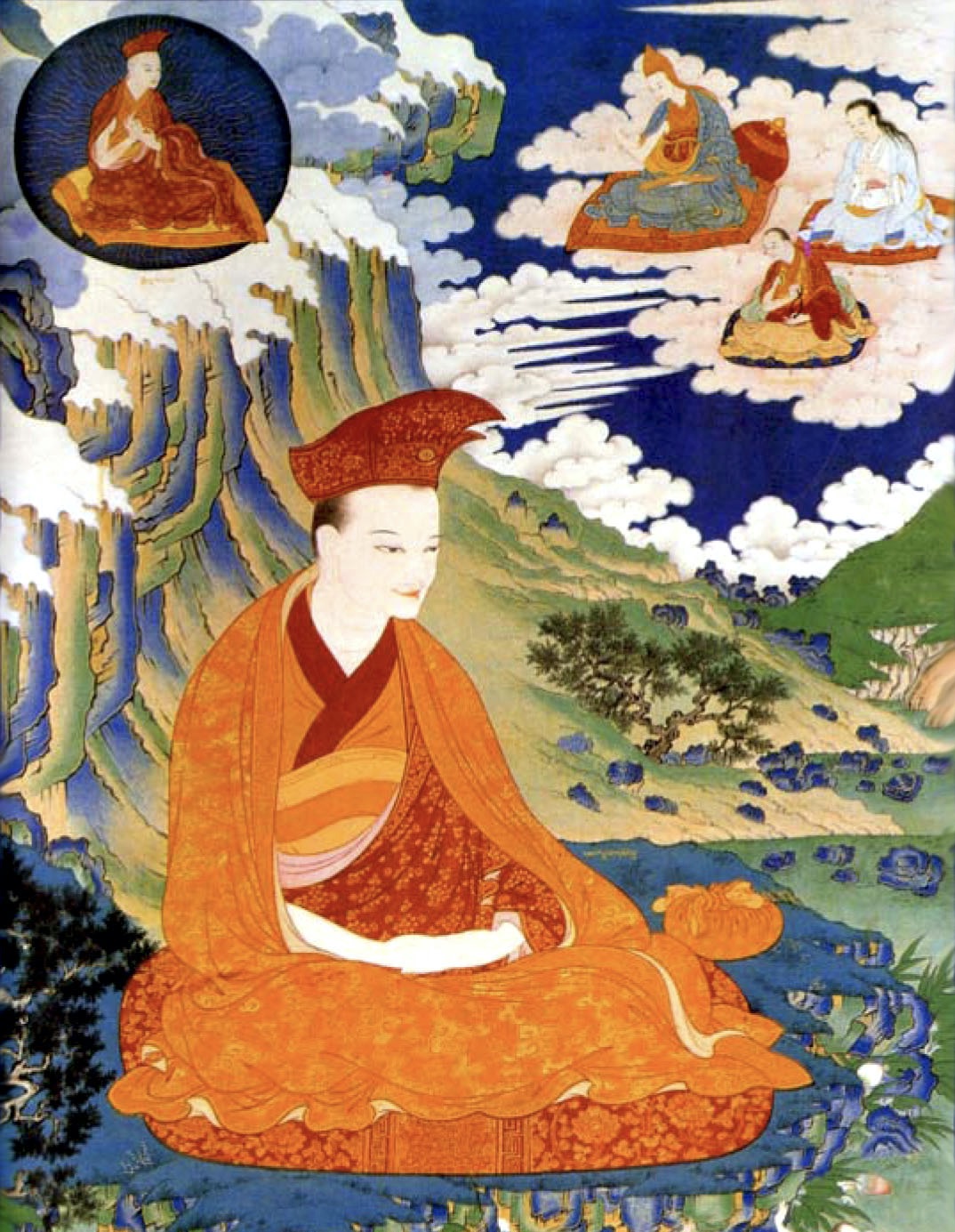
As important and indispensable as Gampopa’s training with Milarepa was, recent research on Gampopa’s collected works show clearly that even years after Gampopa completed his training with Milarepa and had become a prominent teacher with a large following, he still signed some of his writings and letters identifying himself as “a Kadam monk.” Therefore, Dakpo Kagyu—Gampopa’s Kagyu—is a unique practice lineage (Tibetan: drupgyu སྒྲུབ་བརྒྱུད་) that arose from Gampopa’s practice and realization of the totality of teachings and transmissions that he received both from his Kadam teachers and from Milarepa. In blending these two streams together in his own practice and realization, Gampopa in turn had his own style of teaching and much of what makes the Kagyu lineage unique is due to Gampopa’s unique situation. In particular, the way Gampopa trained his students in mahamudra not just through explicitly Vajrayana sources and methods (which was the way Marpa and Milarepa took primarily), but also through Sutrayana meditative practices and texts (which some Kadam lineage masters appear to have preferred) became a characteristic of Dakpo Kagyu mahamudra. Furthermore, Gampopa sometimes even taught mahamudra in a way that did not rely on either explicitly Sutrayana or Vajrayana sources—an approach that he sometimes called “essence mahamudra.” Among Gampopa’s spiritual descendants in the various branches of the Kagyu lineage, we can in turn see differences and nuances to mahamudra cultivation that can be traced to Gampopa’s own versatility and flexibility. In Drikung Kagyu in particular, while Kyobpa Jikten Sumgon did teach mahamudra using different approaches depending on the intended audience, overall the main system he taught—known as “the fivefold mahamudra” or “mahamudra in five aspects”— is as an approach that blends so-called Sutrayana, Vajrayana and “essence” elements together.

As His Holiness’s verse of praise above puts it, “Hundreds of thousands of saffron-robe wearers…lit up the sky with the color of dawn.” These are the spiritual successors and descendants of Gampopa who like him were monastics instead of “neither-lay-nor-monastic” wandering yogis like Milarepa or family-man, landowning tantric masters like Marpa. Among the most famous immediate disciples of Gampopa were Dusum Khyenpa (1110–1193, the first Black Hat Karmapa), Barom Darma Wangchuk (1127–1199) and Pakmodrupa. Like Gampopa, all three lived as monks.
PAKMODRUPA (1110–1170) was already an advanced practitioner and recognized teacher when he arrived at Daklha Gampo. Tradition has it that he came to Daklha Gampo not to join the ranks of Gampopa’s disciples but to debate Gampopa on Gampopa’s unusual approach to mahamudra. At that point, Pakmodrupa had already received transmissions from masters of many different tantric lineages active in his time, training with notable Kadam masters and, most significantly, having become one of the most promising disciples of the renowned Sachen Kunga Nyingpo of the Sakya lineage. Training under this great Sakya patriarch for twelve years, Pakmodrupa became an authority in the lamdre system of the Sakyapas. But rather than succeeding in refuting Gampopa, Pakmodrupa became a disciple and in less than two years completely realized the meaning of all the teachings he ever received and achieved the result of mahamudra.

Having realized the essence of the teachings in a short time, Pakmodrupa’s genuine qualities can be seen in the way he kept his conduct humble and reverential toward everyone at Daklha Gampo. He kept his monastic vows impeccably, eschewed wealth and material comfort and dedicated his life to benefiting others.
Pakmodrupa in time became a great master with disciples surpassing in numbers even those of Gampopa. This was prophesied by Milarepa, who once said that unlike the usual course of other lineages, his lineage would become greater and more potent with each successive generation. In the valley of Ngamsho at a place called Pakmodru, five hundred “masters with parasols” gathered as Pakmodrupa’s disciples —“master with parasol” referring to a teacher with his own following of disciples. Pakmodrupa’s seat became known as Densatil (literally, “the headquarters”) as from it many branches of the Kagyu lineage proliferated and thrived in all directions throughout Tibet.

Although Pakmo Densatil was brimming with great disciples and thriving with uninterrupted Dharma teachings and practice, Pakmodrupa often hinted that his most important successor had yet to appear. While this puzzled some and sparked speculations among his community, for the most part those at Densatil did not think much about this matter until the arrival of a seemingly insignificant young lay practitioner from Eastern Tibet.

It is said that the appearance of KYOBPA JIKTEN SUMGON (1143–1217) in Tibet was prophesied by the Buddha in various sutras and tantras. Some accounts consider him as the emanation of the Lord of Secrets, Vajrapani, while others say he was Vimalakirti, Nagarjuna and the Dharma-king Relpachen. Yet other accounts say he was a buddha of the past by the name of Nagakulapradipa or that he was the bodhisattva Manjushri. Although a special being by all accounts, Jikten Sumgon’s life was filled with challenges and difficulties.
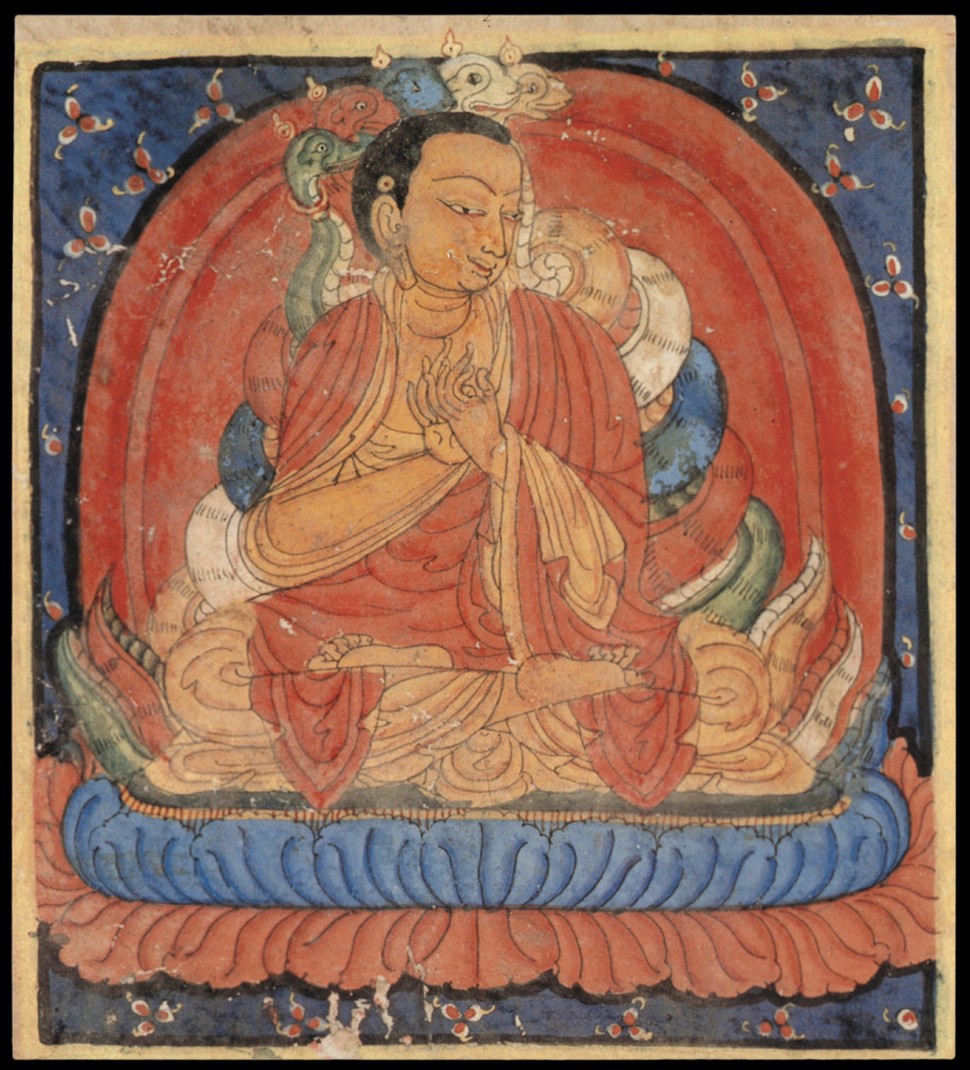
He and his family suffered famines when he was young. His father who was an authority on Vajrabhairava practice died impoverished when he was fifteen, and within a year his mother died as well. Historical records show that there was a famine that killed many in Jikten Sumgon’s area. His uncle, who was also his Dharma teacher, died the year after his mother’s death, and two years later his sister died as well. Through all of it, Jikten Sumgon never gave up on practicing Dharma. He taught others Dharma at a young age, impressing many with his mastery of the Vajrakilaya system of practice he received from his uncle. Although he experienced many sublime states while practicing the various methods imparted to him by different teachers from the Kadam and Nyingma lineages, and gained supernormal powers and the power to heal and attracted much attention and patrons, it wasn’t until he heard the name of Pakmodrupa that he felt a definite connection and certainty in direction.
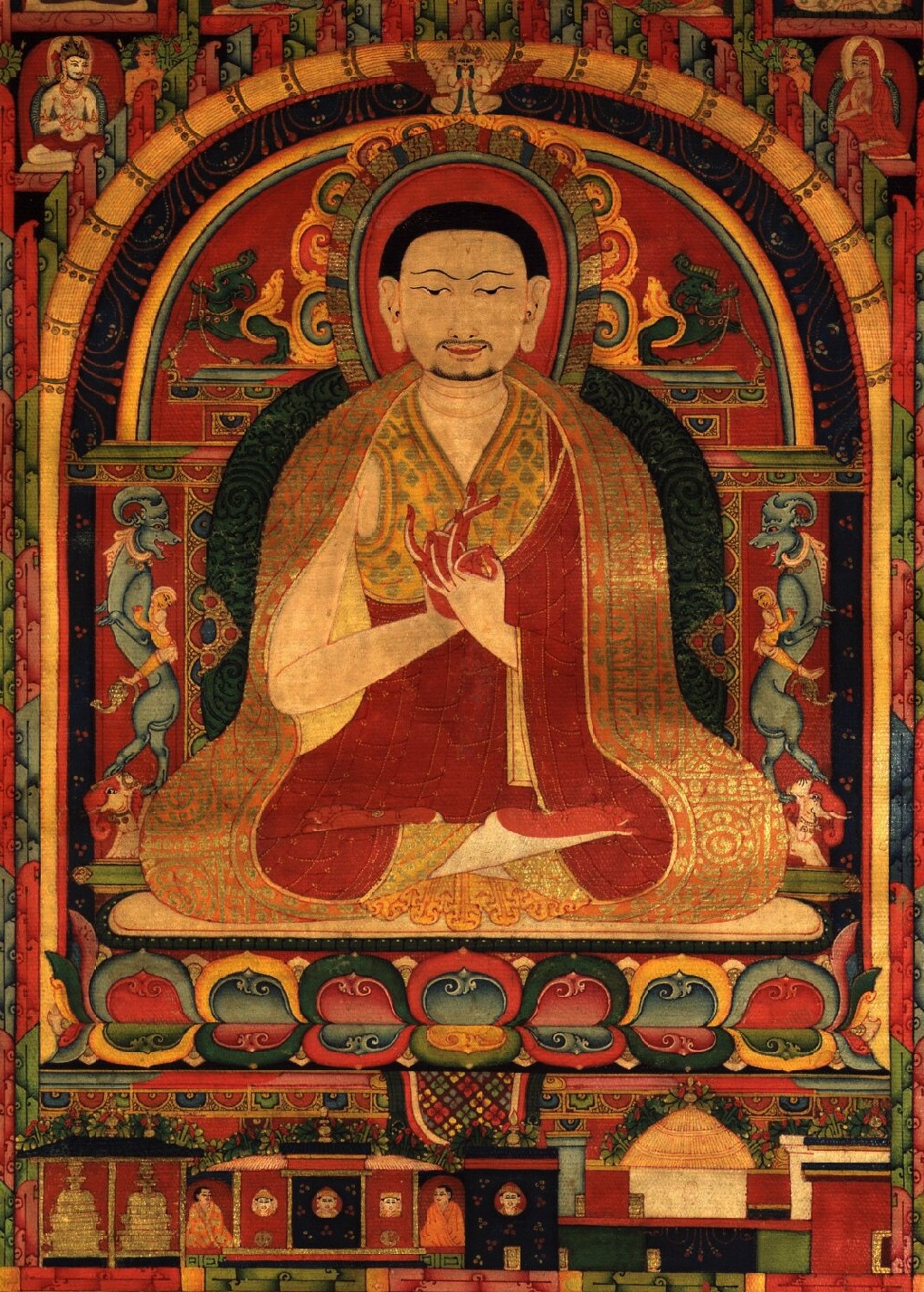
Meanwhile, prior to Jikten Sumgon arriving at Pakmo Densatil, Pakmodrupa apparently divulged to his close disciples that his successor would be a “layman who is a tenth-level bodhisattva from Kham.” Thus Pakmodrupa’s inner-circle—with senior disciples like his long term attendant Taklungtangpa (1142–1209) and Lingrepa (1128–1188)— probably knew that the newly arrived Jikten Sumgon wasn’t a random nobody from Eastern Tibet who had stumbled his way over to Pakmodrupa’s feet. And while Jikten Sumgon came across to everyone at Densatil as a confident, if not outright arrogant young man, it was also clear that he was completely dedicated to Dharma practice and wasn’t afraid of enduring hardships and owning up to his faults. Everyone could also see that he cared little about his clothing, food and other natural comforts. But at the same time, many probably resented his seeming judgmental and self-righteous attitude. But regardless, they could also see that their teacher took great care with Jikten Sumgon. Many in fact noted that after Jikten Sumgon arrived, Pakmodrupa gave teachings and instructions in a way that he had never done before. Now, Paknodrupa taught without any reservations, without holding back. He gave many profound and direct instructions both publicly to everyone at Densatil and also privately to Jikten Sumgon.
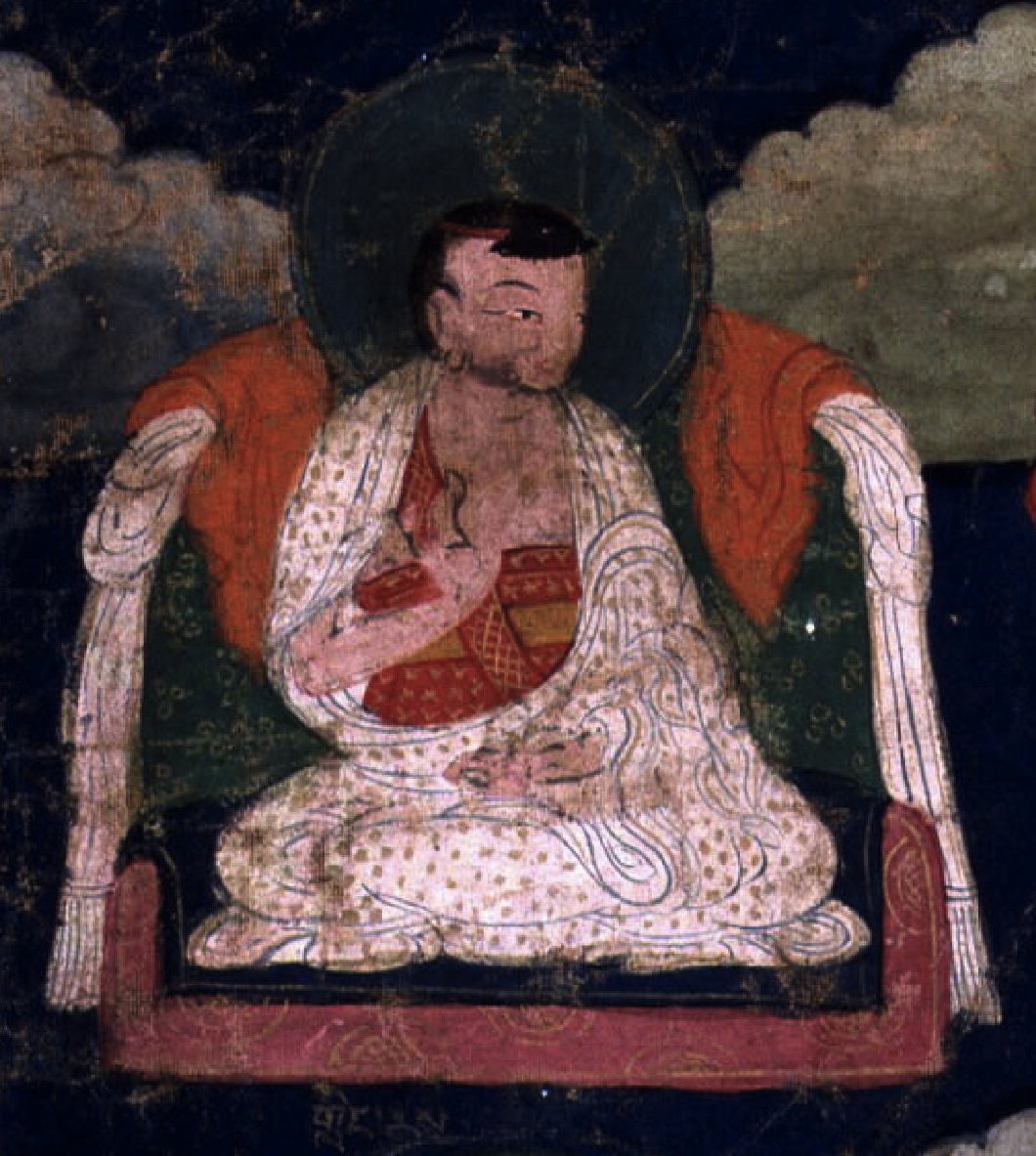
In all, Jikten Sumgon spent a little under three years training in the essence of mahamudra practice with Pakmodrupa before Pakmodrupa’s passing in 1170. In that short period of time, it was evident to everyone that Jikten Sumgon was no ordinary person. While he had a relatively low formal status at Pakmo Densatil—he wasn’t even a monk in the monastic-centered community and had only recently arrived—at Pakmodrupa’s passing, the heavy responsibility of anchoring the community fell on him. He was designated as the chief mourner as an eldest son would for a deceased father. While giving his very best to stabilize and center the community after the passing of their guru, Jikten Sumgon received further detailed teachings of Pakmodrupa from Pakmodrupa’s senior disciples. In time, due to problems that arose at Densatil and his own longing for retreat, Jikten Sumgon eventually left. After some travel to holy places and other teachers, Jikten Sumgon settled at Echung Cave and remained mostly in retreat for almost eleven years in total, with some interruptions in between.
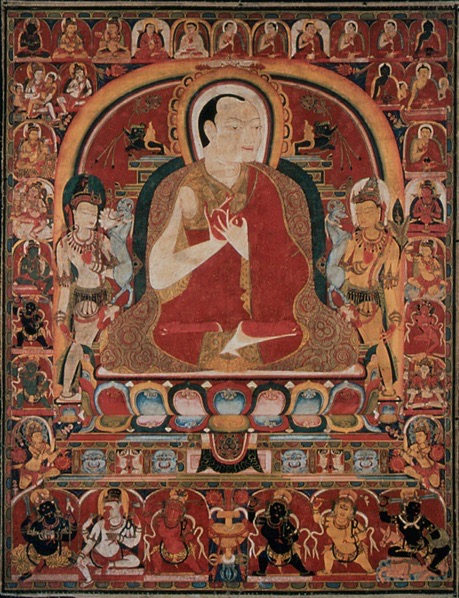
During these retreats, Jikten Sumgon successively purified himself of all negative karma, completely dispelled all confusions and fully achieved the final result of mahamudra. Jikten Sumgon directly perceived interdependent origination “in both directions”—how samsara arose and ceased. He completely realized emptiness as well as the interdependence of cause and effect. Starting at the age of thirty five when he achieved full awakening at Echung, Jikten Sumgon began to explicitly engage in activities of benefiting others: he taught and guided students, arbitrated between opposing political powers and interests, healed the sick, pacified and bound unruly local spirits, distributed alms to the poor and needy, rebuilt and restored sacred sites, commissioned the production of sacred images and texts, and sent meditators into retreats at holy mountain sites.

In 1179 Jikten Sumgon finally established his main seat in the Drikung region of Central Tibet, thus giving the branch of the Kagyu lineage that emerged from him the name “Drikung Kagyu.” Just as Pakmodrupa’s following exceeded Gampopa’s, Jikten Sumgon’s disciples exceeded Pakmodrupa’s many times over. Traditional sources claim that there were as many as 50,000 gathered in Drikung at one point.
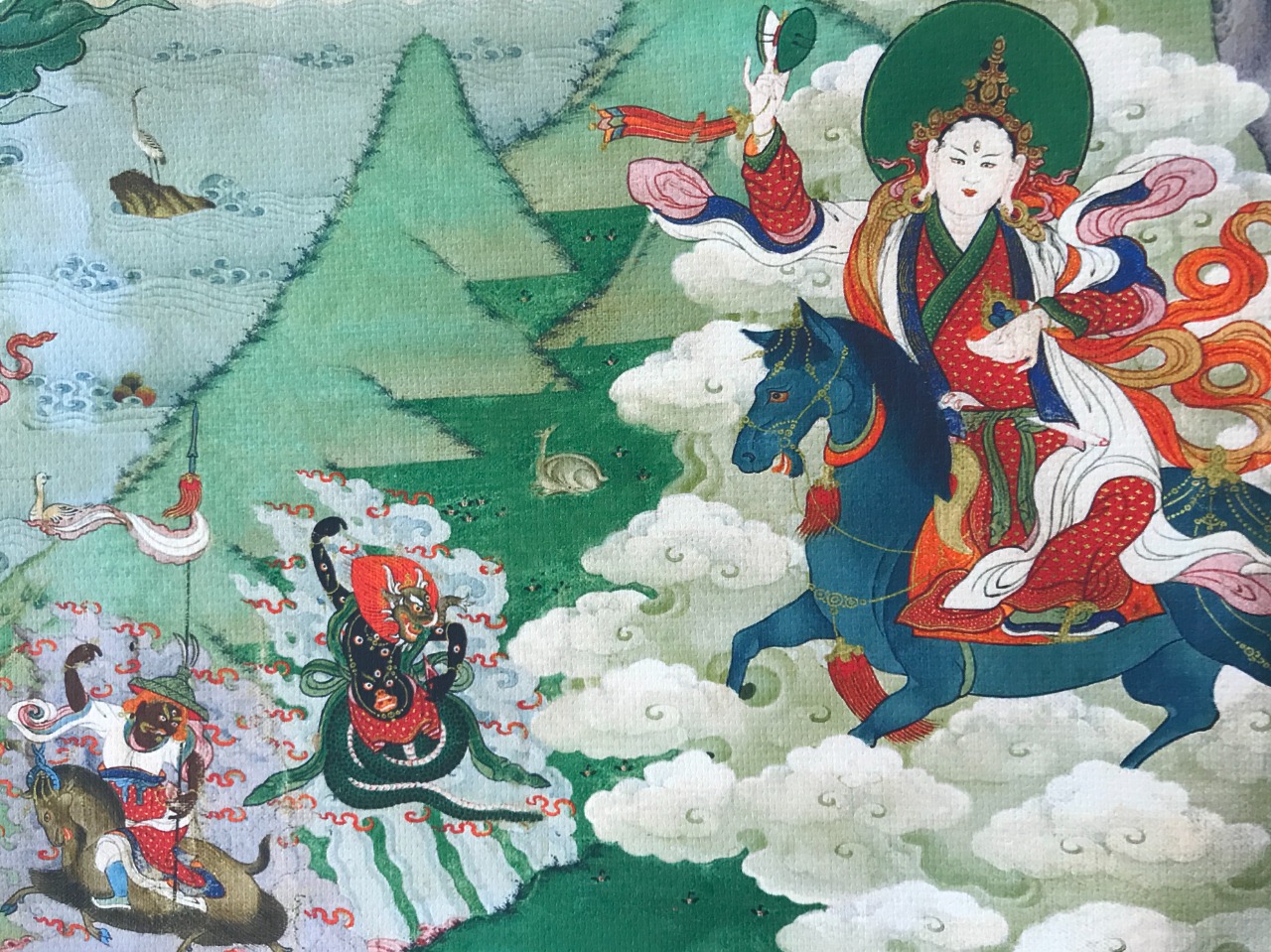
The choice of Drikung Valley, while seeming accidental—apparently one of Pakmodrupa’s senior disciples offered his retreat hut in Drikung to Jikten Sumgon—turned out to be the result of an auspicious interdependence that went back a few generations. Four generations previously, an unusual woman fiercely dedicated to the Dharma came from Drikung to Kham in Eastern Tibet and basically strong-armed an older Khampa yogi by the name of Ame Tsultrim Gyatso to start a family with her, as their descendants would “greatly benefit beings in the future.” This accomplished yogini, by the name of Chokyi Drolma, was in fact Kyobpa Jikten Sumgon’s paternal great-grandmother. And to this day, it is said that Achi (Grandma) Chokyi Drolma protects and guides all the spiritual descendants of Jikten Sumgon. This is an example of the principle of tendrel (literally, “interdependent origination”) at work—specifically, auspicious tendrel. Due to tendrel initiated by his paternal great-grandmother, Jikten Sumgon established his community at his ancestral land of Drikung. And from there, his teachings flourished into the far reaches of Tibet and beyond—to Tangut, China, Ladakh, Nepal, Mongolia, Bhutan and even Persia. Today, like other lineages of Tibetan Buddhism, Drikung Kagyu has become an international Buddhist lineage, with centers, temples, stupas, hermitages, monasteries and nunneries all around the world.
In the year 1217, Kyobpa Jikten Sumgon passed into mahaparinirvana at the age of 75. When asked by his closest disciple and nephew, Chenga Sherab Jungne to which pureland disciples should direct their prayers to him after his passing, Kyobpa Rinpoche responded with the following: “Right here is that buddha-field—how could it be anywhere else? I am forever at where your mind and mahamudra are inseparable. Never part from cultivating your own mind! This is how you can be inseparable from me.”
